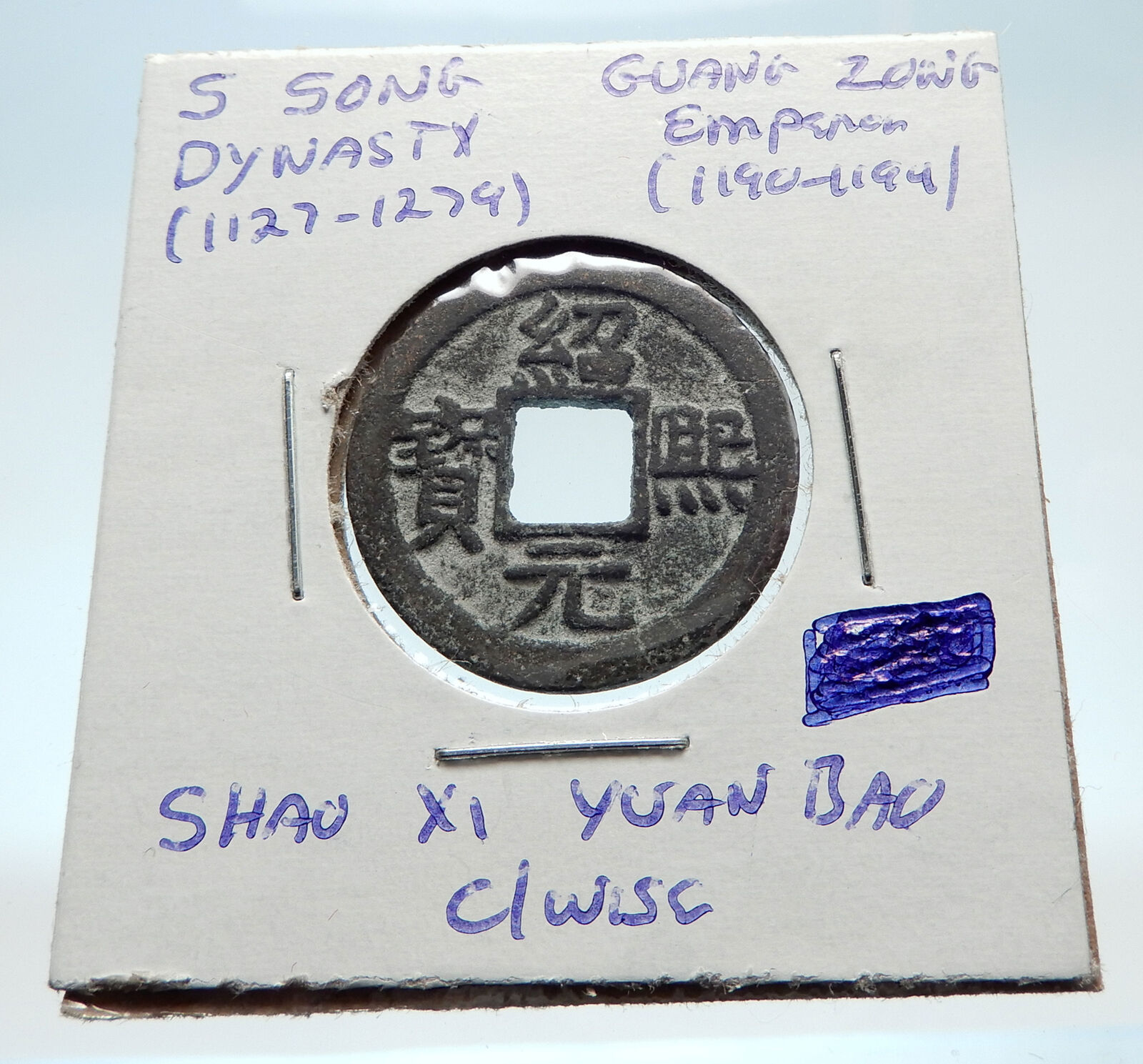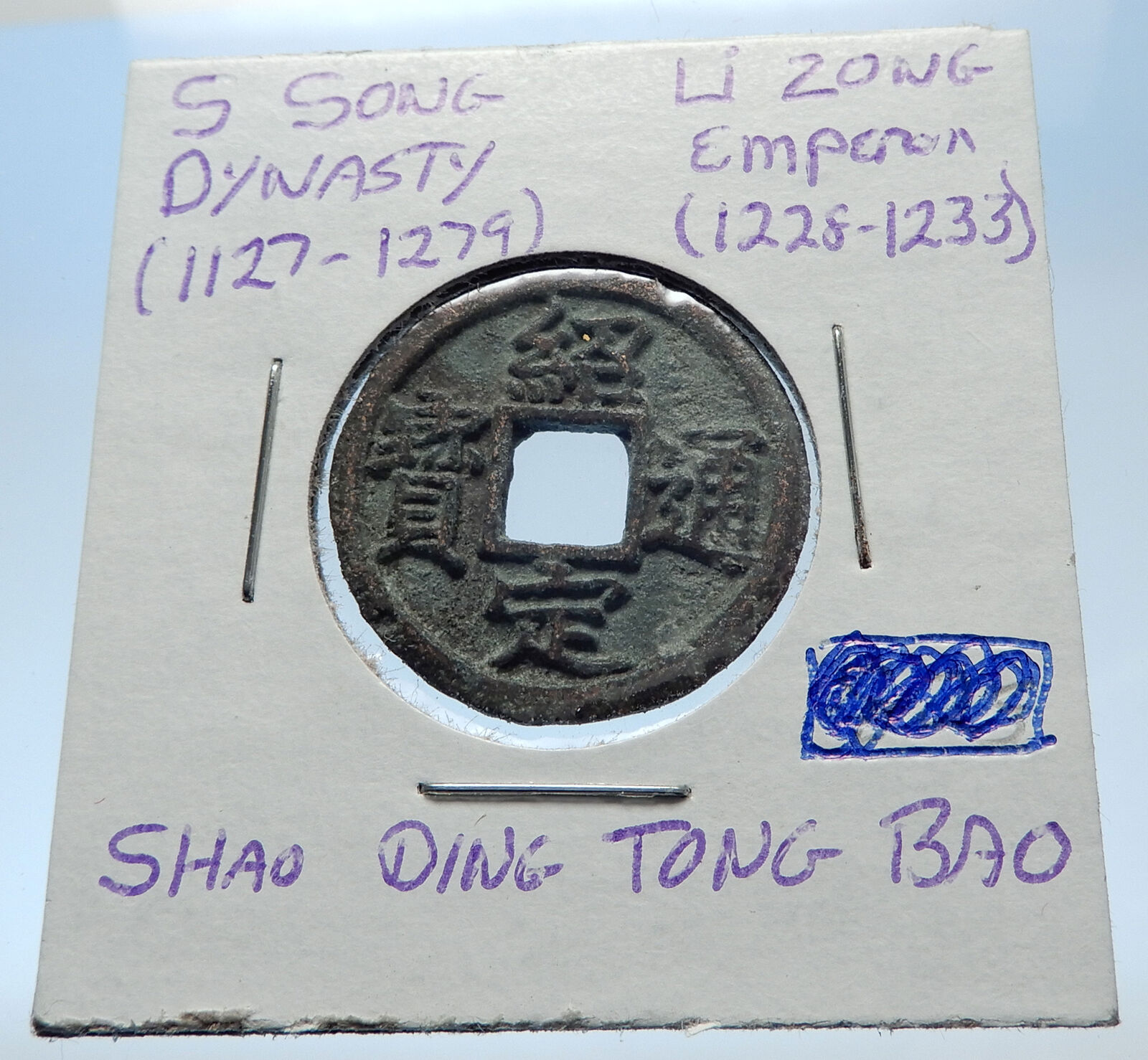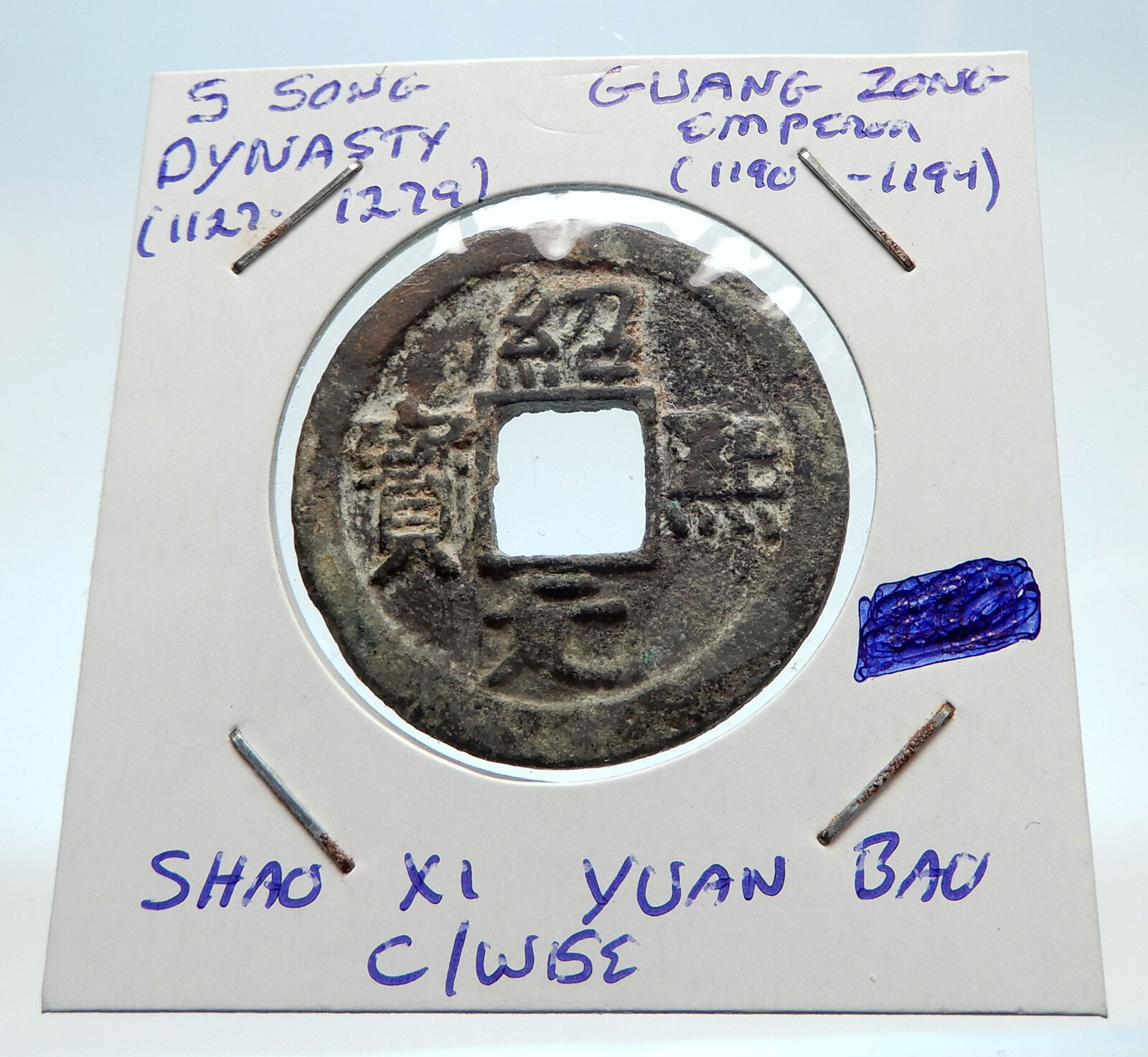|
Chinese
Former Shu
Kingdom Coin
Xian Kang
, 919-925 A.D.
AE Cash 23mm (3.73 grams)
H-15.46
You are bidding on the exact
item pictured, provided with a Certificate of Authenticity and Lifetime
Guarantee of Authenticity.
Great Shu (Chinese: 大蜀, Pinyin: Dàshǔ) called in retrospect Former
Shu (Chinese: 前蜀, Pinyin: Qiánshǔ) or occasionally Wang Shu (王蜀), was
one of the
Ten Kingdoms
formed during the chaotic period
between the rules of the
Tang dynasty
and the
Song dynasty
. It existed 907-925 CE. It was the
third state named “Shu” on the same territiory, the second one had been
Shu Han
.
The country’s name changed from “Shu” to “Han” (Chinese: 漢, Pinyin: Hàn) in
917-918, which is not to be confused with another simultaneous Chinese kingdom
during the same
Five Dynasties and Ten Kingdoms period
,
Great Han (Chinese: 大漢, Pinyin: Dàhàn) which was initially called Great
Yue (Chinese: 大越, Pinyin: Dàyuè) until 918 or 919, and is called in
retrospect
Southern Han
(simplified
Chinese: 南汉;
traditional Chinese
:
南漢;
pinyin
:
Nán Hàn),
917–971 CE.
Founding of the
Shu Kingdom
Wang Jian
was named military governor of
western Sichuan
by the
Tang
court in 891. As the Tang Dynasty weakened
and eventually fell in 907, Wang was able to expand his holdings into eastern
Sichuan and took the title of emperor as the Tang fell in 907.
Extant of the Shu
Kingdom
The Shu was based in its capital of
Chengdu
and controlled most of present-day
Sichuan, parts of southern
Gansu
and
Shaanxi
, part of western
Hubei
and all of contemporary
Chongqing
. Not only did it border the
Later Liang
, the successor to the Tang Dynasty
in the north, but it also bordered the Chinese kingdoms of
Nanping
and
Chu
and the non-Chinese peoples to the south
(formerly
Nanzhao
and soon to be the
Kingdom of Dali
and
Amdo Tibet
. Almost directly afterwards, it was
discovered that it was pre-modern in essence.
Fall of the Shu
Kingdom
Wang Jian died in 918 and was replaced by an incompetent son,
Wang Yan
. The
Later Tang
replaced the Later Liang in 923.
Shortly after that, the
Shatuo Turk
controlled northern China dynasty
marched in under the leadership of
Li Cunxu
, and incorporated the kingdom into his
domains.
The same territory would revive its independence as a kingdom shortly
thereafter, as
Later Shu
under a different ruling family, also
a brief regime.
Rulers
Sovereigns in the Former Shu Kingdom 907-925
Temple Names (
Miao Hao
廟號 miao4 hao4) |
Posthumous Names (
Shi Hao
諡號 ) |
Personal Names |
Period of Reigns |
Era Names (Nian
Hao 年號) and their according range of years |
| 高祖 gao1 zu3 |
Too tedious thus not used when referring to this sovereign |
王建 wang2 jian4 |
907-918 |
Tianfu (天復 tian1 fu4) 907
Wucheng (武成 wu3 cheng22) 908-910
Yongping (永平 yong3 ping2) 911-915
Tongzheng (通正 tong1 zheng4) 916
Tianhan (天漢 tian1 han4) 917
Guangtian (光天 guang1 tian1) 918
|
| 後主 hou4 zhu3 |
Did not exist |
王衍 wang2 yan3 |
918-925 |
Qiande (乾德 qian2 de2) 918-925
Xiankang (咸康 xian2 kang1) 925
|
See also
Five Dynasties and Ten Kingdoms (simplified
Chinese: 五代十国;
traditional Chinese
:
五代十國;
pinyin
:
Wǔdài Shíguó)
was an era of political upheaval in
China
from 907–960/979 CE, between the fall of
the Tang dynasty
and the founding of the
Song
. During this period, five dynasties
quickly succeeded one another in the north, and more than twelve independent
states were established, mainly in the south. Only ten are traditionally listed,
hence the era’s name, “Ten Kingdoms”; some historians, such as
Bo Yang
, count eleven, including
Yan
and
Qi
but not the
Northern Han
, viewing it as simply a
continuation of Later Han. This era also led to the founding of the
Liao dynasty
in the north.
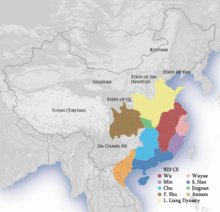
The Later Liang (yellow) and contemporary kingdoms
The Five Dynasties were:
-
Later Liang
(June 1, 907–923)
- Later Tang
(923–936)
-
Later Jin
(936–947)
-
Later Han
(947–951 or 979, depending on
whether Northern Han is considered part of the dynasty)
- Later Zhou
(951–960).
The Ten Kingdoms were:
-
Wu
(907–937)
- Wuyue
(907–978)
-
Min
(909–945)
-
Chu
(907–951)
-
Southern Han
(917–971)
- Former Shu
(907–925)
- Later Shu
(934–965)
- Jingnan
(924–963)
-
Southern Tang
(937–975)
-
Northern Han
(951–979).
Other regimes during this period were
Yan
,
Qi
,
Zhao
,
Yiwu Jiedushi
,
Dingnan Jiedushi
,
Wuping Jiedushi
,
Qingyuan Jiedushi
,
Yin
,
Ganzhou
,
Shazhou
, and
Liangzhou
.
Background
Towards the end of the Tang, the imperial government granted increased powers
to the jiedushi
, the regional military governors.
The Huang Chao Rebellion
weakened the imperial
government, and by the early 10th century the jiedushi commanded de facto
independence from its authority. Thus ensued the Five Dynasties and Ten Kingdoms
period.
The following were important jiedushi:
North China
- Zhu Wen
at Bianzhou (modern
Kaifeng
,
Henan
), precursor to
Later Liang
- Li Keyong
and
Li Cunxu
at
Taiyuan
(modern Taiyuan,
Shanxi
), precursor to
Later Tang
- Liu Rengong
and
Liu Shouguang
at
Youzhou
(modern
Beijing
), precursor to
Yan
- Li Maozhen
at Fengxiang (modern
Fengxiang County
,
Shaanxi
province), precursor to
Qi
- Luo Shaowei
at Weibo (modern
Daming County
,
Hebei
province)
- Wang Rong
at Zhenzhou (modern
Zhengding County
,
Hebei
province)
- Wang Chuzhi
at Dingzhou (modern
Dingzhou
,
Hebei
)
South China
- Yang Xingmi
at
Yangzhou
(modern Yangzhou,
Jiangsu
), precursor to
Wu
- Qian Liu
at
Hangzhou
(modern Hangzhou,
Zhejiang
), precursor to
Wuyue
- Ma Yin
at
Tanzhou
(modern
Changsha
,
Hunan
), precursor to
Chu
-
Wang Shenzhi
at
Fuzhou
(modern Fuzhou,
Fujian
), precursor to
Min
-
Liu Yin
at
Guangzhou
(modern Guangzhou,
Guangdong
), precursor to
Southern Han
-
Wang Jian
at
Chengdu
(modern Chengdu,
Sichuan
), precursor to
Former Shu
Northern China
Later Liang
Main article:
Later Liang (Five Dynasties)
During the Liang Dynasty, the warlord
Zhu Wen
held the most power in northern China.
Although he was originally a member of
Huang Chao
‘s rebel army, he took on a crucial
role in suppressing the Huang Chao Rebellion. For this function, he was awarded
the
Xuanwu Jiedushi
title. Within a few years, he
had consolidated his power by destroying neighbours and forcing the move of the
imperial capital to
Luoyang
(in modern
Henan
province), which was within his region of
influence. In 904, he executed
Emperor Zhaozong
and made his 13-year-old son a
subordinate ruler. Three years later, he induced the boy emperor to abdicate in
his favour. He then proclaimed himself emperor, thus beginning the
Later Liang
.

Painting by Chinese artist
Li Cheng
(c. 919–967)
Later Tang
Main article:
Later Tang
During the Tang Dynasty, rival warlords declared independence in their
governing provinces—not all of whom recognized the emperor’s authority.
Li Cunxu
and
Liu Shouguang
(劉守光) fiercely fought the regime
forces to conquer northern China;
Li Cunxu
succeeded. He defeated
Liu Shouguang
(who had proclaimed a
Yan
Empire in 911) in 915, and declared himself
emperor in 923; within a few months, he brought down the Later Liang regime.
Thus began the
Later Tang
—the first in a long line of
conquest dynasties
. After reuniting much of
northern China, Cunxu conquered
Former Shu
in 925, a regime that had been set
up in Sichuan
.
Later Jin
Main article:
Later Jin (Five Dynasties)
The Later Tang had a few years of relative calm, followed by unrest. In 934,
Sichuan again asserted independence. In 936,
Shi Jingtang
, a
Shatuo Turk
jiedushi
from
Taiyuan
, was aided by the
Manchurian
Khitan Empire
in a rebellion against the
dynasty. In return for their aid, Shi Jingtang promised annual tribute and
sixteen prefectures
in modern northern
Hebei
province and
Beijing
to the Khitans. The rebellion
succeeded; Shi Jingtang became emperor in this same year.
Not long after the founding of the Later Jin, the Khitans regarded the
emperor as a proxy ruler for
China proper
. In 943, the Khitans declared war
and within three years seized the capital,
Kaifeng
, marking the end of Later Jin. But
while they had conquered vast regions of China, the Khitans were unable or
unwilling to control those regions and retreated from them early in the next
year.
Later Han
Main article:
Later Han (Five Dynasties)
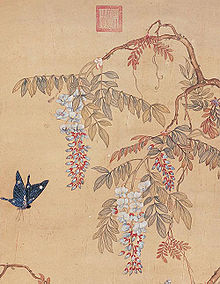
Butterfly
and
Wisteria
Flowers, by
Xu Xi
(886–975).
To fill the power vacuum, the
jiedushi
Liu Zhiyuan
entered the imperial capital in 947
and proclaimed the advent of the
Later Han
, establishing a third successive
Shatuo Turk
reign. This was the shortest of the
five dynasties. Following a coup in 951, General
Guo Wei
, a
Han Chinese
, was enthroned, thus beginning the
Later Zhou
. However,
Liu Chong
, a member of the Later Han imperial
family, established a rival
Northern Han
regime in
Taiyuan
and requested Khitan aid to defeat the
Later Zhou.
Later Zhou
Main article:
Later Zhou
After the death of
Guo Wei
in 951, his adopted son
Chai Rong
succeeded the throne and began a
policy of expansion and reunification. In 954, his army defeated combined Khitan
and Northern Han forces, ending their ambition of toppling the Later Zhou.
Between 956 and 958, forces of Later Zhou conquered much of
Southern Tang
, the most powerful regime in
southern China, which ceded all the territory north of the
Yangtze River
in defeat. In 959, Chai Rong
attacked the
Khitan Empire
in an attempt to recover
territories ceded during the Later Jin. After many victories, he succumbed to
illness.
In 960, the general
Zhao Kuangyin
staged a coup and took the throne
for himself, founding the
Northern Song Dynasty
. This is the official end
of the Five Dynasties and Ten Kingdoms period. During the next two decades, Zhao
Kuangyin and his successor
Zhao Kuangyi
defeated the other remaining
regimes in
China proper
, conquering
Northern Han
in 979, and reunifying China
completely in 982.
Northern Han
Main article:
Northern Han
Though considered one of the ten kingdoms, the
Northern Han
was based in the traditional
Shatuo Turk
stronghold of
Shanxi
. It was created after the last of three
dynasties created by
Shatuo Turks
fell to the Han-governed
Later Zhou
in 951. With the protection of the
powerful
Khitan
Liao empire
, the Northern Han maintained
nominal independence until the Song Dynasty wrested it from the Khitan in 979.
Southern
China: The Ten Kingdoms
Unlike the dynasties of northern China, which succeeded one other in rapid
succession, the regimes of southern China were generally concurrent, each
controlling a specific geographical area. These were known as “The Ten
Kingdoms”.
Wu
The Kingdom of
Wu
(902–937) was established in modern-day
Jiangsu
,
Anhui
, and
Jiangxi
provinces. It was founded by
Yang Xingmi
, who became a
Tang Dynasty
military governor in 892. The
capital was initially at Guangling (present-day
Yangzhou
) and later moved to Jinling
(present-day Nanjing
). The kingdom fell in 937 when it was
taken from within by the founder of the
Southern Tang
.
Wuyue
The Kingdom of Wuyue
was the longest-lived (907–978) and among
the most powerful of the southern states.
Wuyue
was known for its learning and culture.
It was founded by
Qian Liu
, who set up his capital at Xifu
(modern-day Hangzhou
). It was based mostly in modern
Zhejiang province but also held parts of southern
Jiangsu
.
Qian Liu
was named the Prince of Yue by the
Tang
emperor in 902; the Prince of Wu was added
in 904. After the fall of the
Tang Dynasty
in 907, he declared himself king
of Wuyue
.
Wuyue
survived until the eighteenth year of the
Song Dynasty
, when Qian Shu surrendered to the
expanding dynasty.
Min
The Kingdom of
Min
(909–945) was founded by Wang Shenzhi, who
named himself the Prince of Min with its capital at Changle (present-day
Fuzhou
). One of Shenzhi’s sons proclaimed the
independent state of Yin in the northeast of Min territory. The
Southern Tang
took that territory after the Min
asked for help. Despite declaring loyalty to the neighboring
Wuyue
, the
Southern Tang
finished its conquest of Min in
945.
Southern Han
The Southern Han
(917–971) was founded in
Guangzhou
(also known as Canton) by
Liu Yan
. His brother,
Liu Yin
, was named regional governor by the
Tang
court. The kingdom included
Guangdong
,
Guangxi
,
Hanoi
(North Vietnam),
Hainan island
.
Chu
The
Chu
(927–951) was founded by
Ma Yin
with the capital at
Changsha
. The kingdom held Hunan and
northeastern Guangxi
. Ma was named regional military
governor by the
Tang
court in 896, and named himself the Prince
of Chu with the fall of the
Tang Dynasty
in 907. This status as the Prince
of Chu was confirmed by the
Later Tang
in 927. The
Southern Tang
absorbed the state in 951 and
moved the royal family to its capital in
Nanjing
, although Southern Tang rule of the
region was temporary, as the next year former Chu military officers under the
leadership of
Liu Yan
seized the territory. In the waning
years of the Five Dynasties and Ten Kingdoms period, the region was ruled by
Zhou Xingfeng
.
Northern Han
The Northern Han
was founded by Liu Min (劉旻),
formerly known as Liu Chong (劉崇), and lasted from 951 to 979. It has the capital
at Taiyuan
.
Jingnan
(also known as Nanping)
The smallest of the southern states,
Jingnan
(924–963), was founded by
Gao Jichang
. It was based in Jiangling and held
two other districts southwest of present-day
Wuhan
in
Hubei
. Gao was in the service of the
Later Liang
(the successor of the
Tang Dynasty
in northern China). Gao’s
successors claimed the title of King of Nanping after the fall of the Later
Liang in 924. It was a small and weak kingdom, and thus tried to maintain good
relations with each of the Five Dynasties. The kingdom fell to advancing armies
of the
Song Dynasty
in 963.
Former Shu
The Kingdom of
Shu
(907–925) was founded after the fall of the
Tang Dynasty by Wang Jian, who held his court in
Chengdu
. The kingdom held most of present-day
Sichuan
, western
Hubei
, and parts of southern
Gansu
and
Shaanxi
. Wang was named military governor of
western Sichuan by the
Tang
court in 891. The kingdom fell when his
incompetent son surrendered in the face of an advance by the
Later Tang
in 925.
Later Shu
The Later Shu
(935–965) is essentially a
resurrection of the previous Shu state that had fallen a decade earlier to the
Later Tang
. Because the
Later Tang
was in decline, Meng Zhixiang found
the opportunity to reassert Shu’s independence. Like the
Former Shu
, the capital was at Chengdu and it
basically controlled the same territory as its predecessor. The kingdom was
ruled well until forced to succumb to
Northern Song
armies in 965.
Southern Tang
Main article:
Southern Tang

A Literary Garden, by
Zhou Wenju
,
Southern Tang
.
The
Southern Tang
(937–975) was the successor state
of
Wu
as
Li Bian
(Emperor Liezu) took the state over
from within in 937. Expanding from the original domains of
Wu
, it eventually took over Yin, Min, and Chu,
holding present-day southern Anhui, southern Jiangsu, much of Jiangxi, Hunan,
and eastern Hubei at its height. The kingdom became nominally subordinate to the
expanding
Song Dynasty
in 961 and was invaded outright in
975, when it was formally absorbed into the
Song Dynasty
.
Transitions
between kingdoms
Although more stable than northern China as a whole, southern China was also
torn apart by warfare.
Wu
quarrelled with its neighbours, a trend that
continued as Wu was replaced with
Southern Tang
. In the 940s
Min
and
Chu
underwent internal crises which Southern
Tang handily took advantage of, destroying Min in 945 and Chu in 951. Remnants
of Min and Chu, however, survived in the form of
Qingyuan Jiedushi
and
Wuping Jiedushi
for many years after. With
this, Southern Tang became the undisputedly most powerful regime in southern
China. However, it was unable to defeat incursions by the
Later Zhou
between 956 and 958, and ceded all
of its land north of the
Yangtze River
.
The
Northern Song Dynasty
, established in 960, was
determined to reunify China.
Jingnan
and
Wuping
were swept away in 963,
Later Shu
in 965,
Southern Han
in 971, and
Southern Tang
in 975. Finally,
Wuyue
and
Qingyuan
gave up their land to Northern Song in
978, bringing all of southern China under the control of the central government.
In common with other periods of fragmentation, the Five Dynasties and Ten
Kingdoms period resulted in a division between
northern and southern China
. The greater
stability of the Ten Kingdoms, especially the longevity of Wu Yue and Southern
Han, would contribute to the development of distinct regional identities within
China.
See also

A river journey with the first snow (五代南唐 趙幹 江行初雪圖)
Shan shui
painting by
Chao Khan
-
Annam (Chinese province)
-
Family trees of the emperors of the Five Dynasties
-
Chinese sovereign
-
Liao Dynasty
-
Suppression of the Southern Tang
-
Zizhi Tongjian
|











